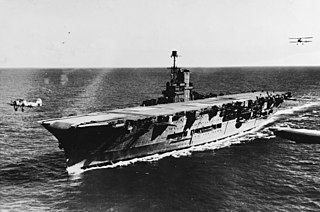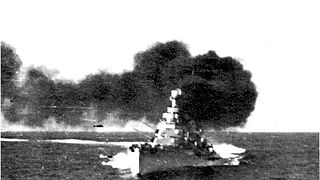
HMS Ark Royal was an aircraft carrier of the Royal Navy that was operated during the Second World War.

HMS Hasty was an H-class destroyer built for the Royal Navy during the mid-1930s. She was assigned to the Mediterranean Fleet until the beginning of World War II. The ship transferred to Freetown, Sierra Leone, in October 1939 to hunt for German commerce raiders in the South Atlantic with Force K. Hasty returned to the British Isles in early 1940 and covered the evacuation of Allied troops from Namsos in early May 1940 during the Norwegian Campaign. She was transferred back to the Mediterranean Fleet shortly afterwards and participated in the Battle of Calabria and the Battle of Cape Spada in July 1940. The ship took part in the Battle of Cape Matapan in March and evacuated British and Australian troops from both Greece and Crete in April and May. In June, Hasty participated in the Syria-Lebanon Campaign and was escorting convoys and the larger ships of the Mediterranean Fleet for the next year. During the Second Battle of Sirte in March 1942 she defended a convoy from an Italian battleship and several cruisers. While covering another convoy from Alexandria to Malta in June 1942 during Operation Vigorous, Hasty was torpedoed by a German motor torpedo boat and was so badly damaged that she had to be scuttled.

HMS King George V was the lead ship of the five British King George V-class battleships of the Royal Navy. Laid down in 1937 and commissioned in 1940, King George V operated during the Second World War in all three major naval theatres of war, the Atlantic, Mediterranean and Pacific, as well as part of the British Home Fleet and Pacific Fleets. In May 1941, along with HMS Rodney, King George V was involved in the hunt for and pursuit of the German battleship Bismarck, eventually inflicting severe damage which led to the German vessel's sinking. On 1 May 1942 the destroyer HMS Punjabi sank after a collision with King George V in foggy conditions. King George V took part in Operation Husky and bombarded the island of Levanzo and the port of Trapani. She also escorted part of the surrendered Italian Fleet, which included the battleships Andrea Doria and Duilio, to Malta. In 1945 King George V took part in operations against the Japanese in the Pacific.

HMS Resolution was one of five Revenge-class battleships built for the Royal Navy during the First World War. Completed in December 1916, Resolution saw no combat during the war as both the British and German fleets adopted a more cautious strategy after the Battle of Jutland in May owing to the increasing threat of naval mines and submarines.

The attack on Mers-el-Kébir on 3 July 1940, during the Second World War, was a British naval attack on neutral French Navy ships at the naval base at Mers El Kébir, near Oran, on the coast of French Algeria. The attack was the main part of Operation Catapult, a British plan to neutralise or destroy neutral French ships to prevent them from falling into German hands after the Allied defeat in the Battle of France. The British bombardment of the base killed 1,297 French servicemen, sank a battleship and damaged five other ships, for a British loss of five aircraft shot down and two crewmen killed. The attack by air and sea was conducted by the Royal Navy, after France had signed armistices with Germany and Italy, coming into effect on 25 June.

The Battle of Cape Spartivento, known as the Battle of Cape Teulada in Italy, was a naval battle during the Battle of the Mediterranean in the Second World War, fought between naval forces of the Royal Navy and the Italian Regia Marina on 27 November 1940.

HMS Antelope was a British A-class destroyer, which was completed for the Royal Navy in 1930. Antelope served throughout the Second World War, taking part in the sinking of three enemy submarines and in Operation Torch, the Allied invasion of French North Africa.

HMS Arethusa was the name ship of her class of light cruisers built for the Royal Navy. She was built by Chatham Dockyard, with the keel being laid down on 25 January 1933. She was launched on 6 March 1934, and commissioned 21 May 1935 by Captain Philip Vian.

HMS Foresight was one of nine F-class destroyers built for the Royal Navy during the 1930s. She was assigned to the Home Fleet upon completion. Unlike her sister ships, she does not appear to have been attached to the Mediterranean Fleet in 1935–36 during the Abyssinia Crisis, nor did she enforce the arms blockade imposed by Britain and France on both sides of the conflict the Spanish Civil War of 1936–1939. The ship escorted the larger ships of the fleet during the early stages of World War II and played a minor role in the Norwegian Campaign of 1940. Foresight was sent to Gibraltar in mid-1940 and formed part of Force H where she participated in the attack on Mers-el-Kébir and the Battle of Dakar. The ship escorted numerous convoys to Malta in 1941 and Arctic convoys during 1942. Later that year, Foresight participated in Operation Pedestal, another convoy to Malta. She was torpedoed by an Italian aircraft on 12 August and had to be scuttled the next day.

Admiral of the Fleet Sir James Fownes Somerville, was a Royal Navy officer. He served in the First World War as fleet wireless officer for the Mediterranean Fleet where he was involved in providing naval support for the Gallipoli Campaign. He also served in the Second World War as commander of the newly formed Force H: after the French armistice with Germany, Winston Churchill gave Somerville and Force H the task of neutralizing the main element of the French battle fleet, then at Mers El Kébir in Algeria. After he had destroyed the French Battle fleet, Somerville played an important role in the pursuit and sinking of the German battleship Bismarck.

The Battle of the Mediterranean was the name given to the naval campaign fought in the Mediterranean Sea during World War II, from 10 June 1940 to 2 May 1945.

Operation Collar wasa small, fast three-ship during the Second World War. The convoy left Britain on 12 November 1940 and passed Gibraltar on 24 November, escorted by two cruisers, to ships for Malta and one bound for Alexandria. Numerous other operations took place partly as diversions and the Italian Fleet sailed to attack British ships, leading to the inconclusive Battle of Cape Spartivento on 27 November. The two merchant ships reached Malta on 26 November.

The Malta convoys were Allied supply convoys of the Second World War. The convoys took place during the Siege of Malta in the Mediterranean Theatre. Malta was a base from which British sea and air forces could attack ships carrying supplies from Europe to Italian Libya. Britain fought the Western Desert Campaign against Axis armies in North Africa to keep the Suez Canal and to control Middle Eastern oil. The strategic value of Malta was so great the British risked many merchant vessels and warships to supply the island and the Axis made determined efforts to neutralise the island as an offensive base.

HMS Fearless was an F-class destroyer built for the Royal Navy during the 1930s. Although assigned to the Home Fleet upon completion, the ship was attached to the Mediterranean Fleet in 1935–36 during the Abyssinia Crisis. During the Spanish Civil War of 1936–1939, she spent time in Spanish waters, enforcing the arms blockade imposed by Britain and France on both sides of the conflict. Several months after the start of the war in September 1939, Fearless helped to sink one submarine and sank another one in 1940 during the Norwegian Campaign. She was sent to Gibraltar in mid-1940 and formed part of Force H where she participated in the attack on the Vichy French ships at Mers-el-Kébir and the bombardment of Genoa. Fearless helped to sink one final submarine in 1941 and escorted many Malta convoys in the Mediterranean before she was torpedoed by an Italian bomber and had to be scuttled on 23 July 1941.

HMS Forester was one of nine F-class destroyers built for the Royal Navy during the early 1930s. Although assigned to the Home Fleet upon completion, the ship was attached to the Mediterranean Fleet in 1935–36 during the Abyssinia Crisis. A few weeks after the start of World War II in September 1939, she helped to sink one German submarine and then participated in the Second Battle of Narvik during the Norwegian Campaign of 1940. Forester was sent to Gibraltar in mid-1940 and formed part of Force H where she participated in the attack on the Vichy French ships at Mers-el-Kébir and the Battle of Dakar between escorting the aircraft carriers of Force H as they flew off aircraft for Malta and covering convoys resupplying and reinforcing the island until late 1941. During this time the ship helped to sink another German submarine.

HMS Foxhound was one of nine F-class destroyers built for the Royal Navy in the mid-1930s. Although she was assigned to the Home Fleet, the ship was detached as part of the Mediterranean Fleet to enforce the arms blockade imposed by Britain and France on both sides during the Spanish Civil War of 1936–39. Several weeks after the start of the Second World War in September 1939, Foxhound helped to sink a German submarine and participated in the Second Battle of Narvik during the Norwegian Campaign of April–June 1940. The ship was sent to Gibraltar in mid-1940 and formed part of Force H where she participated in the attack on Mers-el-Kébir. Foxhound escorted the aircraft carriers of Force H as they flew off aircraft for Malta and covered convoys resupplying and reinforcing the island until late 1941. During this time the ship helped to sink another German submarine.

HMS Fury was an F-class destroyer built for the Royal Navy in the 1930s. Although assigned to the Home Fleet upon completion, the ship was attached to the Mediterranean Fleet in 1935–36 during the Abyssinia Crisis. During the Spanish Civil War of 1936–1939, she spent time in Spanish waters, enforcing the arms blockade imposed by Britain and France on both sides of the conflict. The ship escorted the larger ships of the fleet during the early stages of World War II and played a minor role in the Norwegian Campaign of 1940. Fury was sent to Gibraltar in mid-1940 and formed part of Force H where she participated in the attack on Mers-el-Kébir and the Battle of Dakar. The ship escorted numerous convoys to Malta in 1940–41 and Arctic convoys during 1942.

HMS Wishart (D67) was a Modified W-class destroyer of the British Royal Navy that saw service in World War II. She spent most of her wartime career based at Gibraltar, engaged in convoy defence, but also served in various naval and military operations in the Mediterranean Sea.

Operation Hurry was the first British operation in a series that have come to be known as Club Runs. The goal of the operation was to fly twelve Hurricane Mk I fighters from HMS Argus to Malta, guided by two Blackburn Skuas. Force H, based in Gibraltar, took the opportunity to raid Elmas airfield in Sardinia and conduct a deception operation with HMS Enterprise. The Mediterranean Fleet conducted diversions in the eastern Mediterranean and the Aegean Sea.
World War II was the first war where naval aviation took a major part in the hostilities. Aircraft carriers were used from the start of the war in Europe looking for German merchant raiders and escorting convoys. Offensive operations began with the Norwegian campaign where British carriers supported the fighting on land.



















